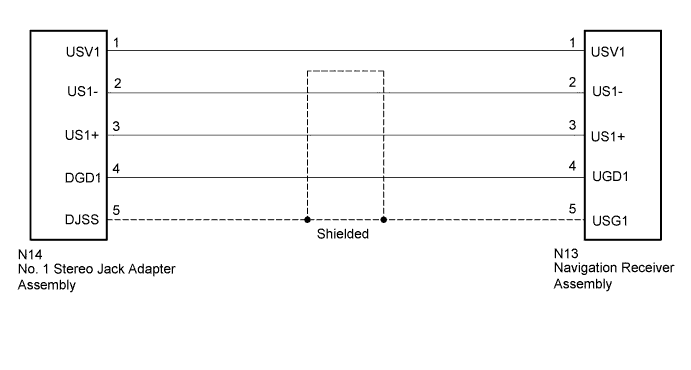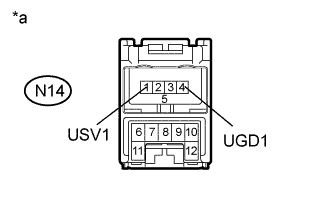NAVIGATION SYSTEM > USB Audio System Recognition/Play Error |
DESCRIPTION
When a USB device or "iPod" is connected to the USB jack of the No. 1 stereo jack adapter assembly, it must have playable files. The device must also communicate with and be recognized by the navigation receiver assembly. This diagnosis procedure is for when a device is not recognized, or files from the device cannot be played normally.WIRING DIAGRAM

INSPECTION PROCEDURE
- HINT:
- When a large amount of data is in a USB device, it may take a while to begin play.
- When using a USB device, files that are protected by copyright cannot be played.
- When files are not played in the sorted order, perform the following procedure before inspection.
- Add numbers in front of the file names.
- Put the files in a folder and copy the folder data to the USB device.
| 1.CHECK USB DEVICE OR "iPod" |
Disconnect the USB device or "iPod" from the No. 1 stereo jack adapter assembly.
Check if playable files are present on the USB device or "iPod".
- HINT:
- Refer to System Description for playable files (Click here).
Check if the USB device is a compatible format or "iPod" is a compatible version.
- HINT:
- Refer to System Description for compatible formats and versions (Click here).
Result Result Proceed to No playable files exist, or incompatible device format or version A Playable files exist, and compatible device format or version B
|
| ||||
| A | ||
| ||
| 2.CHECK HARNESS AND CONNECTOR (NAVIGATION RECEIVER ASSEMBLY - NO. 1 STEREO JACK ADAPTER ASSEMBLY) |
Disconnect the N14 No. 1 stereo jack adapter assembly connector.
Disconnect the N13 navigation receiver assembly connector.
Measure the resistance according to the value(s) in the table below.
- Standard Resistance:
Tester Connection Condition Specified Condition N14-1 (USV1) - N13-1 (USV1) Always Below 1 Ω N14-2 (US1-) - N13-2 (US1-) Always Below 1 Ω N14-3 (US1+) - N13-3 (US1+) Always Below 1 Ω N14-4 (UGD1) - N13-4 (UGD1) Always Below 1 Ω N14-5 (UJSS) - N13-5 (USG1) Always Below 1 Ω N14-1 (USV1) - Body ground Always 10 kΩ or higher N14-2 (US1-) - Body ground Always 10 kΩ or higher N14-3 (US1+) - Body ground Always 10 kΩ or higher N14-4 (UGD1) - Body ground Always 10 kΩ or higher N14-5 (UJSS) - Body ground Always 10 kΩ or higher
|
| ||||
| OK | |
| 3.CHECK NAVIGATION RECEIVER ASSEMBLY (NO. 1 STEREO JACK ADAPTER ASSEMBLY POWER SOURCE) |
Reconnect the N13 navigation receiver assembly connector.
Measure the voltage according to the value(s) in the table below.
- Standard Voltage:
Tester Connection Switch Condition Specified Condition N14-1 (USV1) - N14-4 (UGD1) Ignition switch ACC 4.5 to 5.5 V
Text in Illustration *a Front view of wire harness connector
(to No. 1 Stereo Jack Adapter Assembly)
 |
|
| ||||
| OK | |
| 4.FORMAT USB DEVICE OR RESTORE "iPod" AND RECHECK |
Delete all files in the USB device or "iPod" and format/restore it.
Save the data again and check if it can be played on the in-vehicle device.
- NOTICE:
- Formatting a USB device or restoring an "iPod" erases all music on the device. Ensure that backup music data is available before performing this operation.
- OK:
- Malfunction disappears.
|
| ||||
| OK | ||
| ||
| 5.REPLACE USB DEVICE OR "iPod" |
Turn the ignition switch off.
- HINT:
- When this malfunction occurs, it is necessary to turn off the ignition switch to make it possible for the vehicle to recognize a new device when it is connected.
Turn the ignition switch to ACC.
Connect a known good USB device or "iPod" to the No. 1 stereo jack adapter assembly.
- HINT:
- If the malfunction occurred when a USB device was in use, use another USB device for the inspection. If the malfunction occurred when an "iPod" was in use, use another "iPod" for the inspection.
- Refer to System Description for compatible formats and versions (Click here).
| NEXT | |
| 6.CHECK USB DEVICE OR "iPod" |
Check if a USB device or "iPod" is recognized by the navigation receiver assembly, and if information such as track, artist and album names are displayed on the screen.
- OK:
- Malfunction disappears.
|
| ||||
| OK | ||
| ||
